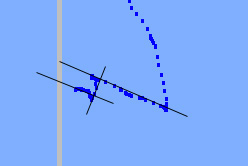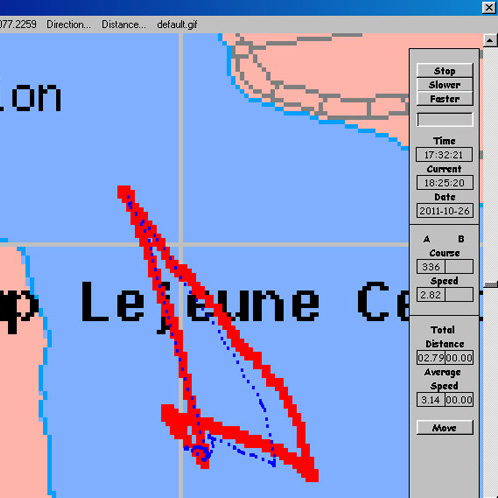 You tack and come out of the tack pointing a little lower. As your speed increases, you point up or pinch. Pinch too much and you are going to come to a stop.
You tack and come out of the tack pointing a little lower. As your speed increases, you point up or pinch. Pinch too much and you are going to come to a stop.
 Click Image For The Sailboat Company's Home Page
Click Image For The Sailboat Company's Home Page
Sailing Techniques
What we can learn from racing.
The Com-Pac Yacht Association of North Carolina raced on 12 May. Click on the left to see the results. The wind that day was 10 knots or less with a wind out of the southeast. The idea was to do a short race that we could talk about at dinner and still have time for some free sailing in the area that afternoon. We distributed maps of the river at the Captain's meeting before the race. They were very small and you had to have good eyes to read the course on the map. Everyone wanted to know where marker 19 was and I forgot to tell everyone that a tall water tank was behind the mark. Some racers had a hard time finding the mark. Sorry about that. We started 5 minutes late because we waited for another boat to arrive. Of the three boats with GPS receivers, the Legacy 16 looked to be very fast in the light air. The 19 started the race first (red boat) with the Legacy (blue boat) close behind. The first two positions stayed the same for the entire race. John Day said he tried to pass Wes Newman several times without any luck. After looking at the race results, I'm guessing that following someone else down the racecourse is going to give the following boat lots of bad air. If you could see the air behind a sailboat, we would see something that looks like a spiraling column of air. This column of air moves as the boat moves and can be persistant for several minutes or even longer. Sailing in someones else bad air is like wading in water up to your knees. It's not going to be very fast. The only solution to the blue boat's problem would have been to pass on the windward side (clean air side). The bad air moves downwind slowly in light air. Of course, the red boat had that big genoa and maybe it just wasn't going to be passed.
Two old friends recently raced a Com-Pac 16 over a racecourse on the New River in North Carolina. We recorded the results with our GPS and I displayed the results on this Web site in October. Chick the CP-16 Race on the left. I ran the data through another software program and determined that we have some additional information to share. The slow blue boat had a higher average speed than the winning red boat. The slow blue boat sailed 3.29 miles and the faster red boat sailed 2.79 miles. The big question is why did the fast boat come in last in a 2 boat race?
When we pinch or sail too close to the wind, we point high but we can be slow. Boats that don't pinch will always sail a little faster than boats that do pinch. Lets say pinching is when the jib tell-tails are pointing up at a 45-degree angle. Lets also say that not pinching is when your tell tails stream aft in a horizontal plane. That difference between the two is 3 degrees of boat heading. Pinching just the right amount is important for upwind performance and pointing. My Web software program recorded more tacks for the red boat and fewer tacks for the blue boat. The additional tacks were really extra pinching done by the red boat. Both boats had about the same boat speed throughout the race. The big difference was in the total distance sailed. That means that our pinching technique helped win the race for the red boat.
All boats have a center of lateral resistance (CLR) and that's their pivot point when they change directions or tack. By putting the crew aft on the low side, the keel points higher. Both crewmembers can only go to the low side in light wind and this happened as we approached the wind shadow caused by the tree line on shore. Being aft in the cockpit on the low side caused the boat to heel and the keel to point higher on the first upwind leg. The red boat started sailing a shorter course with that technique. Both boats didn't get a 45-degree tack at the first tack point. I think we may have missed the right point because we were too cautious. We also didn't point our arm at the target, as we should have done. As you approach your tack point, the person at the tiller should point at the target while holding his or her arm perpendicular to the boat. As you pass that point, it's time to tack if your boat can do a 45-degree tack. What we both did was an error. If the red boat did 45-degree tacks close to the mark in very light wind, it should have been able to do 45-degree tacks with more wind. More wind moves the center of effort aft in the sails and that produces more weather helm and the boat points up. Weather helm can be a good thing sometimes.
When the air is super light, the jib becomes a scoop or wind vane for the main. Find the wind with the jib and then direct it to the reduced slot between the jib and main. With the 16, we put the clew inside the shrouds. You use your hands to adjust the slot for size and shape by holding it in the right position. The air between the jib and main will move much faster if the slot size is reduced in very light wind. This powers the main giving us a little bit of weather helm helping us point upwind. A genoa may have too much surface drag to accomplish this thick in light air. Both boats used a jib in this light wind. The red boat squeezed the air between the jib and main as we short tacked upwind to the mark. We got our act together and the red boat's tacks were 45 degrees.  You tack and come out of the tack pointing a little lower. As your speed increases, you point up or pinch. Pinch too much and you are going to come to a stop.
You tack and come out of the tack pointing a little lower. As your speed increases, you point up or pinch. Pinch too much and you are going to come to a stop.
The red boat's outboard motor made a roaring sound like a low flying airplane or helicopter on the last leg. The speed of the boat with the prop in the water was making the noise. The blue boat didn't have the same noise and you might think the red boat was faster on the last leg. The recorded data said the red boat wasn't faster. Both boats sailed about the same speed on the last leg. The noise caused by the prop may have slowed the red boat some. I'm not sure.
Had we really been hot to win the race and maybe a little younger, we would have hot tacked in the light wind. If you are on the low side and sailing into a tack, getting around through the eye of wind with no power is difficult. On a power tack, you shift your body to the new low side just in time to help the boat get through the no wind area. This helps the sails move to right position to power up and go. Getting 2 people to power tack at the same time could look pretty funny. Maybe that's why we didn't do it.
The graphic below shows the other software with the boat colors changed. The blue boat is the red boat and the red boat is blue boat. Sorry about that.
